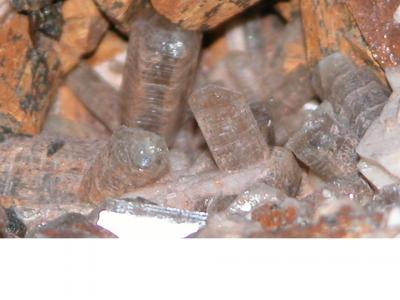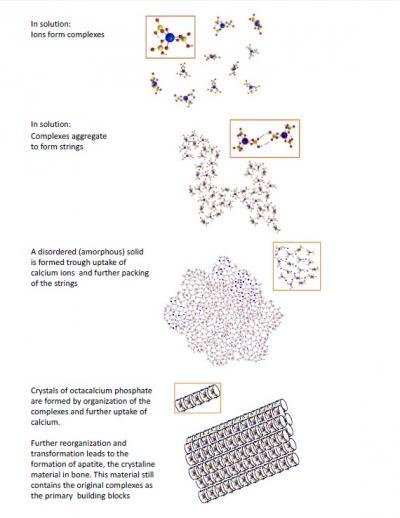Exactly how a crystal forms from solution is a problem that has occupied scientists for decades. Researchers at Eindhoven University of Technology (TU/e), together with researchers from Germany and the USA, are now presenting the missing piece. This classical theory of crystal formation, which occurs widely in nature and in the chemical industry, was under fire for some years, but is saved now. The team made this breakthrough by detailed study of the crystallization of the mineral calcium phosphate –the major component of our bones. The team published their findings yesterday in the online journal Nature Communications.
Crystallization is the formation of a solid ordered substance, such as happens when water freezes. In nature, crystals are mostly formed from ions which are dissolved in water, as for example in the formation of shells or bone. This involves the clustering of ions into increasingly large nuclei, until a crystal is formed when a certain size is reached. However, the details of this growth process have been the subject of discussion for many years.
According to the existing theories, it is individual ions that group together to form crystal nuclei. But in 2009 chemists led by dr. Nico Sommerdijk (TU/e) showed the presence of an intermediate step in the growth process of calcium carbonate crystals. The ions were thought to first form small clusters, which then grow into crystal nuclei. This finding, which was the cover story of Science, caused controversy because it appeared to contradict the classical crystallization theories which did not allow for such an intermediate step.

Apatite, a form of calcium phosphate and the major component of bone.
(Photo Credit: (c) Eindhoven University of Technology/Wouter Habraken.)
Now Sommerdijk is having second thoughts about his 2009 conclusions. At least, the answer now turns out to be more subtle than was thought at that time. Together with researchers from the Max Planck Institute in Germany and the Lawrence Berkeley National Laboratory in the USA, he looked more closely at the role of these so-called pre-nucleation clusters in the growth process of the mineral calcium phosphate. Using a cryo-electron microscope, which makes images of deep-frozen samples, he was able to identify the precise components of the clusters and study the growth process in detail.
In their article in Nature Communications Sommerdijk concludes that the clusters do not form a clearly defined intermediate step, but instead are part of a gradual growth process. Sommerdijk refers to the formation of clusters as a 'false start' by the ions, because the clusters already start to organize themselves step by step while still in solution, without actually forming growth nuclei. This new understanding means the existing theories no longer need to be overturned. Sommerdijk's team now complete the theory by describing alternative 'pathways' along which crystals can form. Sommerdijk's new conclusions have since been confirmed in a second study into crystal formation in the mineral magnetite, which was published online this month in Nature Materials.

A diagram that illustrates the crystallization process.
(Photo Credit: (c) Eindhoven University of Technology/Nico Sommerdijk)
In recent years both the role and the composition of the pre-nucleation clusters were the subject of intense scientific discussions, for example last summer during the prestigious Faraday Discussions. There were also disagreements within the team itself about Sommerdijk's new interpretation. Some team members held onto the original scenario, even after numerous new experiments had confirmed that the clusters did not have the same composition and role as believed earlier. Finally it was decided to submit the article, which after four years of experimenting and revision had reached a final length of almost 100 pages, without the names of the team members who were unable to accept the new ideas.
In Sommerdijk's view the most important questions about the formation of crystals have now been answered. This theoretical knowledge is important in many fields, because of the widespread occurrence of crystallization in nature and in the chemical industry. Just a few examples are the formation of coral in the sea, the production of pharmaceuticals and the design of nanoparticles. It could for example help to make production processes less costly, faster or more energy-efficient.

This is Nico Sommerdijk.
(Photo Credit: Bart van Overbeeke/Eindhoven University of Technology.)